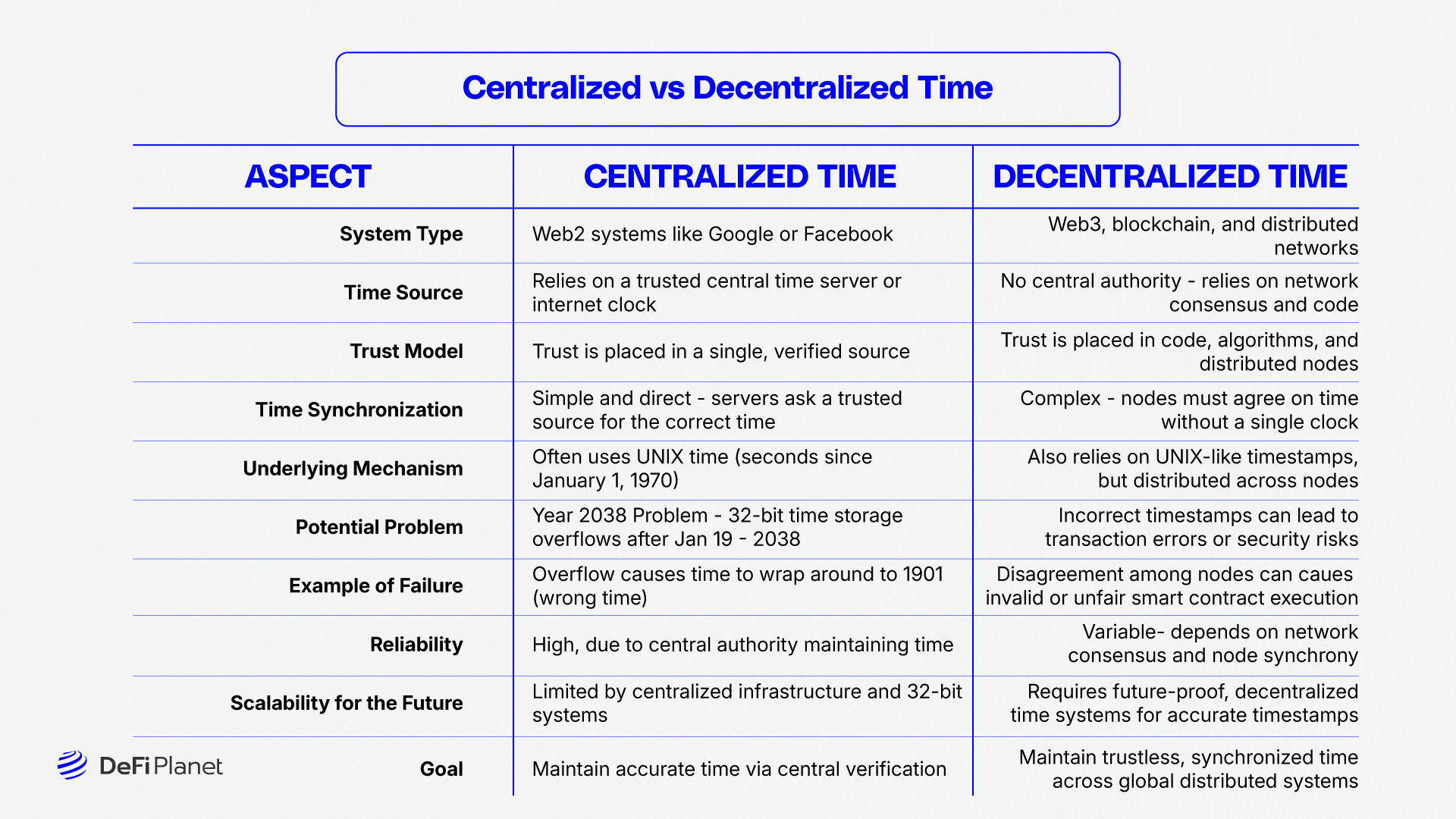Imagine if no one in the world could agree on what time it is, where one person says it’s 3:00 PM, another says it’s 3:02 PM, and someone else thinks it’s still lunchtime. In the real world, we have clocks, phones, and the internet to help us stay in sync, but in the world of Web3, where computers run code without any central authority, setting the clock becomes a much bigger deal.
So, who sets the clock in Web3? Let’s dive into the world of decentralized timekeeping and see why it’s important, how it works, and what makes it challenging.
What is Timekeeping and Why Does it Matter?
Timekeeping is simply keeping track of time. In normal life, time tells us when to wake up, go to school, eat dinner, or watch our favourite shows. For computers and networks, time is also pretty important.
In Web3 and blockchain, time helps decide:
- When a transaction happened
- When a smart contract should run
- When a reward should be given
- When a game move is allowed
If everyone’s clock is different, many things could go wrong: a contract might run too early, a reward might be delayed, or someone could cheat the system. That’s why decentralized timekeeping is so important. It ensures that we are keeping track of time without trusting just one clock, person, or central authority.
Centralized vs Decentralized Time

In the old Web2 world (like apps run by Google or Facebook), servers just ask a trusted time source, like a time server or an internet clock, and get the correct time. This was pretty simple, but in Web3, there’s no central server, and everything is built on trustless systems, which means people don’t have to trust each other. Instead, they trust the code and the network, and this, for one, makes keeping time much harder. If we can’t trust a single clock, how can we make sure all nodes (computers in the network) agree on the same time?
Most computer systems (like UNIX, which many servers use) keep track of time by counting the number of seconds since a special starting point: January 1, 1970, and this is called the UNIX epoch; instead of storing the actual date, the computer stores just a number like “17,000,000,000 seconds since 1970.” This number is stored in a binary format (1s and 0s), and the number of bits used decides how high it can count, with older systems using 32-bit integers to store this time.
Here’s where the problem comes in: a 32-bit signed integer can only count up to 2,147,483,647 seconds and if you convert that number of seconds into a calendar date, you get January 19, 2038, after that date, the number overflows; meaning it can’t count up anymore and wraps around to a negative number, which computers interpret as a time in 1901! This is called the Year 2038 problem, similar to the Y2K bug that scared people in 1999.
In decentralized timekeeping, we can’t risk everyone’s clocks breaking or showing the wrong time, mainly since blockchain timestamps, smart contract timing, and trustless systems all rely on accurate clocks. If the base timekeeping breaks, it can lead to incorrect transactions, unfair rewards, or security problems, and that is why Web3 infrastructure needs to be built on future-proof systems. And part of that means upgrading the way we track and store time.
How Blockchains Track Time
Most blockchains don’t have a regular clock and instead use blockchain timestamps. These timestamps are added to each block (a group of transactions) when it’s created. This way, people can know the order of transactions. For example, if Alice were to send Bob 1 ETH before Bob sends 1 ETH back, the blockchain can prove it because the blocks will show the correct order, but here’s the twist: these blockchain timestamps are not always perfect. They depend on the node that creates the block, and sometimes different nodes have slightly different times.
Consensus Time: Agreeing on the Clock
To fix the time problem, blockchains use something called consensus time: a way for all the nodes in the network to agree on what time it is, even if their local clocks are a little different. Let’s say 100 nodes are creating blocks, and each block comes with a timestamp. The network checks if that timestamp is within a normal range (not too far in the past or future), and if it’s too wrong, the block is rejected. This keeps everyone in sync, even if their clocks are a few seconds off.
Consensus time is like when a group of friends decides to meet at “around 5 PM.” Even if one person is a few minutes late, they all agree on the general time.
Smart Contracts and Timing
Smart contract timing is one of the most important parts of decentralized timekeeping. Smart contracts are pieces of code that live on the blockchain and run automatically when conditions are met.
Some contracts need to wait until a certain time to run. For example:
- A lottery that ends at midnight
- A loan that must be repaid in 30 days
- A game that allows moves every 10 minutes
If someone could change the time, they could cheat, and this is why contracts rely on blockchain timestamps and consensus time to know when to act, but what if a smart contract needs the exact time? This is where time oracles come in.
What Are Time Oracles?
Blockchains can’t check the real world on their own as they do not know the weather, stock prices, or even the current time from your phone. That’s why we have oracles, which are special services that bring outside information into the blockchain.
A time oracle is a tool that gives accurate time to smart contracts; it can tell the contract what time it is, and the contract can then act based on that information. But here’s the tricky part: oracles must be trustworthy, and if someone hacks the oracle or gives fake time, they could mess up the whole system.
This is why good Web3 infrastructure includes safe and verified time oracles that many nodes can trust.
The Threat of Temporal Manipulation
One big problem is temporal manipulation, when someone tries to change or lie about the time. Let’s say a miner wants to earn more rewards. They could try to set their blockchain timestamps a few seconds in the past or future to make it look like their block was first. Or they could delay their block just enough to cheat in a game or auction.
While networks try to stop this using consensus time, it’s still not perfect. That’s why researchers are always looking for better ways to protect Web3 from time cheats.
Building Better Web3 Infrastructure
To solve these problems, developers are building stronger Web3 infrastructure that includes better tools for tracking time.
Here are a few ideas being used or tested:
- Multi-source time oracles: Instead of one time source, use several and take the average.
- Trusted execution environments (TEEs): Secure computer parts that provide a reliable time.
- Verifiable delay functions (VDFs): Mathematical ways to prove how much time has passed.
- Decentralized clock networks: Whole new systems built just to provide trusted time.
These tools aim to ensure decentralized timekeeping is safe, accurate, and fair.
Why Decentralized Timekeeping Matters for the Future
You might be wondering, “Why should I care about this?” The reason it matters is that as Web3 continues to grow, it’s becoming the foundation for many things we use and depend on, from digital money and online games to how we vote or track products in a store. These systems aren’t just fun experiments; they’re being built to handle real-life tasks that require accuracy and security. And all of them depend on one crucial thing: time.
Without reliable smart contract timing, these systems can’t work properly. Time tells a smart contract when to unlock a payment, when a game should end, when a vote should be counted, or when a delivery is late. If the time is wrong or someone can change it unfairly, the whole system falls apart. Someone could trick the system to win when they shouldn’t, take money they didn’t earn, or even influence important decisions, such as the outcome of a vote. These aren’t just minor issues; they could harm people and erode trust in the entire Web3 space.
That’s why decentralized timekeeping is so important, because it protects everyone by making sure no one can control or fake time for their own gain. In trustless systems, where no single person or group is in charge, time must be agreed upon by the entire network. This helps keep everything honest and functioning as it should. As more of our daily lives move onto blockchains, having a fair and secure way to track time isn’t just useful; it’s absolutely necessary. Without it, Web3 couldn’t work the way it promises to: open, fair, and for everyone.
Final Thoughts: Who Sets the Clock?
So, back to our question: who sets the clock in Web3?
The answer is both simple and complex, everyone and no one. There isn’t a single master clock or central timekeeper. Instead, Web3 relies on a mix of systems working together. The network agrees on the time using something called consensus time, and each block on the blockchain carries its own blockchain timestamp. Smart contracts are written with built-in timing rules, and time oracles help feed accurate time from external sources into the blockchain. All of this is possible thanks to a strong and evolving Web3 infrastructure, which is designed to support these trustless systems.
Rather than being controlled by any one company or government, time in Web3 is managed by the very people and machines that keep the blockchain alive, and that is what makes it decentralized timekeeping: a system where time belongs to the entire community. While it’s still being improved, it’s already proving to be an important part of how Web3 works. As Web3 becomes more common in our everyday lives, we’ll rely on these shared systems more and more to keep everything in sync.
Disclaimer: This article is intended solely for informational purposes and should not be considered trading or investment advice. Nothing herein should be construed as financial, legal, or tax advice. Trading or investing in cryptocurrencies carries a considerable risk of financial loss. Always conduct due diligence.
If you want to read more market analyses like this one, visit DeFi Planet and follow us on Twitter, LinkedIn, Facebook, Instagram, and CoinMarketCap Community.
Take control of your crypto portfolio with MARKETS PRO, DeFi Planet’s suite of analytics tools.”





















